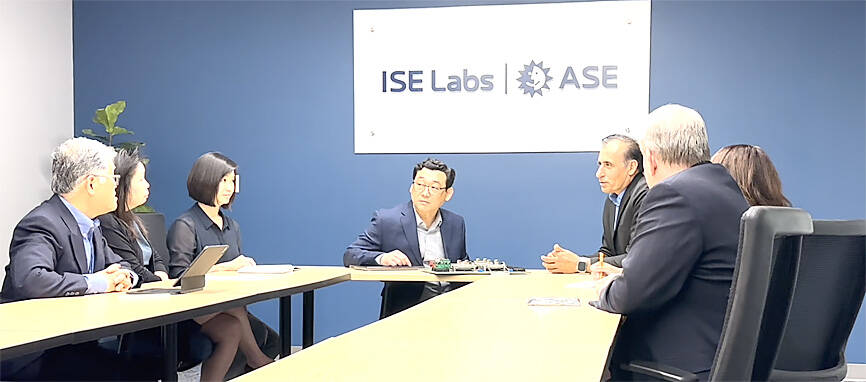ASE Technology Holding Co (ASE, 日月光投控) yesterday launched its second testing facility in San Jose, California, to expand advanced chip testing capacity such as burn-in testing to satisfy customers’ rising engineering needs for emerging semiconductor applications, such as artificial intelligence (AI) and high-performance computing (HPC).
ISE Labs Inc, a fully owned subsidiary of ASE, would operate the advanced testing facility.
When added to its first facility in nearby Fremont, ISE would double its available research-and-development lab and business space to 150,000m2 in hopes of boosting the US semiconductor supply chain, the company said in a statement.

Photo courtesy of ASE Technology Holding Co
“As the semiconductor manufacturing supply chain reshoring continues to escalate, demand for our proven engineering expertise is growing in parallel,” ISE Labs chief executive officer Kenneth Hsiang (項世傑) said in the statement.
“Expanding our operations by adding a second facility is vital to support our growing customers, who are onsite daily due to the collaborative nature of our work,” Hsiang said. “Ease of access in the South [San Francisco] Bay was a key consideration in selecting our new site.”
Numerous customers are working on solutions for AI, machine learning, advanced driver assistance systems and HPC, the statement said.
ISE Labs has spent about US$500 million in the company's US labs and hired more than 200 local employees, company president Jui Ko said. The company expected to invest about US$200 million in the San Jose facility over time in accordance with customers' demand, Ko said.
The San Jose facility would primarily house qualification and reliability processes, including environmental, mechanical, electrostatic discharge, failure analysis, and chip burn-in testing, the statement said.
ISE Labs’ high-power burn-in solutions — vital to detecting early failures in a semiconductor device — are among the best and highest-performing in the industry, it said.
The Fremont site would expand its already robust set of test functions, including automated test equipment program development, test hardware design, device characterization, wafer probing, engineering, pre-production and final testing, and system-level testing, it said.
ASE in April increased its capital spending for the second time, boosting its budget by 10 percent from an earlier estimate of US$2.1 billion to cope with growing demand.
As part of the budget adjustments, the Kaohsiung-based company also planned to allocate a bigger slice of the budget, about 24 percent, for chip testing business from an original estimate of 18 percent to get more non-turnkey solutions business.
ASE is also scouting potential sites to deploy advanced chip packaging capacity in the US, Japan and Mexico, in response to rising demand for improved supply chain resilience amid mounting geopolitical risks, the company said last month.

CHIP RACE: Three years of overbroad export controls drove foreign competitors to pursue their own AI chips, and ‘cost US taxpayers billions of dollars,’ Nvidia said China has figured out the US strategy for allowing it to buy Nvidia Corp’s H200s and is rejecting the artificial intelligence (AI) chip in favor of domestically developed semiconductors, White House AI adviser David Sacks said, citing news reports. US President Donald Trump on Monday said that he would allow shipments of Nvidia’s H200 chips to China, part of an administration effort backed by Sacks to challenge Chinese tech champions such as Huawei Technologies Co (華為) by bringing US competition to their home market. On Friday, Sacks signaled that he was uncertain about whether that approach would work. “They’re rejecting our chips,” Sacks

NATIONAL SECURITY: Intel’s testing of ACM tools despite US government control ‘highlights egregious gaps in US technology protection policies,’ a former official said Chipmaker Intel Corp has tested chipmaking tools this year from a toolmaker with deep roots in China and two overseas units that were targeted by US sanctions, according to two sources with direct knowledge of the matter. Intel, which fended off calls for its CEO’s resignation from US President Donald Trump in August over his alleged ties to China, got the tools from ACM Research Inc, a Fremont, California-based producer of chipmaking equipment. Two of ACM’s units, based in Shanghai and South Korea, were among a number of firms barred last year from receiving US technology over claims they have

BARRIERS: Gudeng’s chairman said it was unlikely that the US could replicate Taiwan’s science parks in Arizona, given its strict immigration policies and cultural differences Gudeng Precision Industrial Co (家登), which supplies wafer pods to the world’s major semiconductor firms, yesterday said it is in no rush to set up production in the US due to high costs. The company supplies its customers through a warehouse in Arizona jointly operated by TSS Holdings Ltd (德鑫控股), a joint holding of Gudeng and 17 Taiwanese firms in the semiconductor supply chain, including specialty plastic compounds producer Nytex Composites Co (耐特) and automated material handling system supplier Symtek Automation Asia Co (迅得). While the company has long been exploring the feasibility of setting up production in the US to address

OPTION: Uber said it could provide higher pay for batch trips, if incentives for batching is not removed entirely, as the latter would force it to pass on the costs to consumers Uber Technologies Inc yesterday warned that proposed restrictions on batching orders and minimum wages could prompt a NT$20 delivery fee increase in Taiwan, as lower efficiency would drive up costs. Uber CEO Dara Khosrowshahi made the remarks yesterday during his visit to Taiwan. He is on a multileg trip to the region, which includes stops in South Korea and Japan. His visit coincided the release last month of the Ministry of Labor’s draft bill on the delivery sector, which aims to safeguard delivery workers’ rights and improve their welfare. The ministry set the minimum pay for local food delivery drivers at